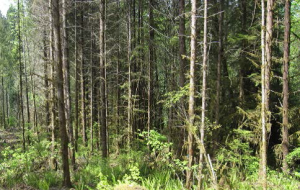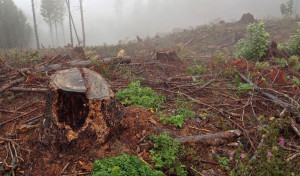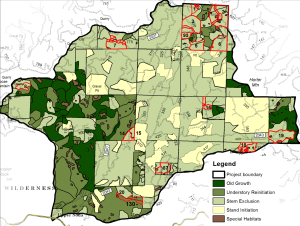By Nick Cady, Legal Director
The conservation community in the Northwest was incredibly excited by Cascadia’s legal victory over the White Castle timber sale. Not just because of the couple hundred acres of old growth forest that were saved from clearcutting, but because of the potentially important precedent the case set concerning logging old forest to create so-called early seral habitat.
A little background. Early seral habitat is the agency name for habitat that is mostly brush and shrubs, ideal habitat for deer, elk and some bird species, and ideally is created after fires have burn through forested areas. True early-seral habitat is somewhat lacking on the landscape because the feds for decades have suppressed fires, and even when there is a fire, the Forest Service or Bureau of Land Management (BLM) will “salvage log” the areas and replant conifer trees, quickly taking away any early-seral habitat value.
Given this pattern of post-fire salvage logging, folks at Cascadia were initially surprised and suspicious to hear about Forest Service and BLM plans to create early-seral habitat through commercial logging. The agency plan was to create this early-seral habitat by logging middle-aged plantations.  These conifer plantations are 40 to 80 year old forests created from previous clearcutting, pesticide spraying, and dense replanting. The logging would essentially create large meadow-like openings between clumps of reserved forests. These reserves would contain the biggest trees in the stand, and areas with unique composition, for example a pocket of western red cedar or large hardwoods. 30% of the project area would be reserved from harvest in these clumps, and there would also be large, green trees, 12 to 18 per acre, distributed across the openings to provide connectivity for wildlife. The logging concept was called ecological forestry or variable retention harvest (VRH).
These conifer plantations are 40 to 80 year old forests created from previous clearcutting, pesticide spraying, and dense replanting. The logging would essentially create large meadow-like openings between clumps of reserved forests. These reserves would contain the biggest trees in the stand, and areas with unique composition, for example a pocket of western red cedar or large hardwoods. 30% of the project area would be reserved from harvest in these clumps, and there would also be large, green trees, 12 to 18 per acre, distributed across the openings to provide connectivity for wildlife. The logging concept was called ecological forestry or variable retention harvest (VRH).

Typical Young Conifer Plantation
Folks at Cascadia were skeptical, but not overly concerned because this prescription seemed genuinely aimed at restoring diversity back into these plantations. Left alone, these middle aged plantations currently provide little to no habitat value for the Northwest’s struggling older forest species, and posed a severe fire risk given the density of these young conifer trees.

BLM's Version of VRH Implemented in the Buck Rising Sale
The White Castle timber sale, located in the South Umpqua watershed on the Roseburg BLM district, was the worst of the worst of these early-seral creation projects we had seen. The sale targeted a one hundred year old-plus forests that had never before been logged. It was also designated critical habitat for the northern spotted owl and hosted a healthy population of the red tree vole, a food source of the northern spotted owl. Forest activists with Cascadia Forest Defenders had occupied the stand to prevent the clearcutting, and Cascadia Wildlands and Oregon Wild readied a legal challenge. We were cautiously optimistic that the judge would recognize how abused this concept to create early-seral forest from plantations had become.
Just over a month ago, the ruling came down, and the Court sided with us on all counts, harping on the fact that this “ecological forestry” was designed for young stands and not older forest. The Northwest has limited older forest left on the landscape, so sacrificing older forest to create early-seral forest does not make sense. It was the epitome of robbing Peter to pay Paul.
This victory threw a major wrench in a number of other “ecological forestry” projects being planned by the Forest Service and BLM, especially the projects slated for older forests.  Cool Soda was one of these projects on the Sweet Home Ranger District of the Willamette National Forest. The project was fairly large, over thousands of acres, and was part of a collaborative process between private timber owners, the Willamette National Forest and conservation groups and other stakeholders trying to get at restoration needs on the landscape across a “checkerboard” ownership.
Cool Soda was one of these projects on the Sweet Home Ranger District of the Willamette National Forest. The project was fairly large, over thousands of acres, and was part of a collaborative process between private timber owners, the Willamette National Forest and conservation groups and other stakeholders trying to get at restoration needs on the landscape across a “checkerboard” ownership.

Map of the Cool Soda Project and Age Classes
The final proposal mostly involved commercial thinning in young plantations to restore ecological diversity while generating timber volume. However, a small portion of the project involved heavy thinning and “ecological forestry” in native, never-logged forests over 120 years old. We objected to the project because of these older forest units, and met with the Forest Service staff to attempt to resolve our differences over the project.
Due to the weight of the White Castle decision and the understanding of the Forest Service, we were able to eliminate the older forest units from the final decision without resorting to litigation. We were able to save all parties’ time and resources and end up with a project that would have a myriad ofbenefits, including restoring diversity into dense young plantations, replacing failed culverts that were impacting aquatic health, and generating timber volume for the local mills.
We are hopeful that moving forward the Forest Service and BLM will honor the original intent of creating early-seral habitat and abandon futile attempts at masking mature forest timber grabs as “ecological” projects.
